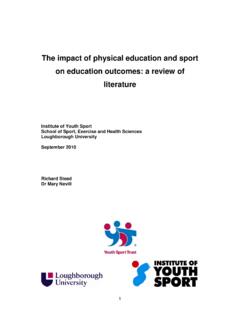Transcription of The Philosophy of Physical Education and Sport from ...
1 International Journal of Environmental & Science Education V o l . 3 , N o . 3 , J u l y 2 0 0 8 , xx-xx The Philosophy of Physical Education and Sport from Ancient Times to the Enlightenment Duygu Harmandar Demirel1* and Ibrahim Y ld ran2 1 Dumlupinar University, Turkey 2 Gazi University, Turkey *E-mail: As an academic discipline, the Philosophy of Sport has been in existence for a relatively short period. Although the Philosophy of Sport as an academic endeavour is relatively young, the philosophical view of Sport itself is not new. Although Sport was a major activity according to the Greeks and Romans, it lost its importance during the Middle Ages. After the Renaissance, Education came to be seen as a necessity.
2 With its incorporation and utilisation in the educational curriculum, Physical Education obviously became more common in the curricula of the Renaissance and Reformation than it had been in the Middle Ages. Opinions about the Sport of ancient times have influenced those of the modern era. The aim of this study is to examine the evolution of Physical training from the renaissance to enlightenment, which is important because this period has laid the foundations of modern Physical training and Sport perception. In this study, the literature is reviewed from ancient times to the enlightenment, and the revolutions and developments that have occurred are emphasised.
3 Key words: ancient time, renaissance, Physical Education , Sport Introduction Movement was seen as an obligatory life activity among humans during primitive ages who viewed movement as lively activity (Alpman, 1972). The need to be constantly prepared for the certainty of life s struggle gave humans a rare Physical fitness, which involved nerve and muscle (Gillet, 1975). At this point, Sport emerged out of the exercises and competitions that athletes used to prepare their bodies and minds for war, and this played a major role in development of the role of Sport in development of Sport cultures (Ongel, 2000). Although the ancient Greeks strove to ensure that Olympian athletes were able to perform at their peak, equal importance was placed on critically examining the nature, purpose and value of Sport and Physical activity in Greek life (Hardman and Jones, 2010).
4 In the ancient world, the greatest success an athlete could achieve was to win the Olympiad crown. The Olympic Games were held every four years for a thousand years from 776 until 393 in honour of Zeus. The traditional date of the founding of the Olympic Games is 776 , but its unofficial beginning dates back farther. In the basic games, although the rewards were symbolic, the champions' own cities held ostentatious display marches during the 3rd and 2nd centuries and provided accommodation, food facilities and theatre seats as well as generous cash rewards (Swaddling, 2000). In ancient Greece, the Hera Games were organised for women and took place every four years (Pfister, 2000); only young girls, not married women, were allowed to participate in these competitions (Spears, 1984).
5 EUROPEAN JOURNAL OF EDUCATIONAL RESEARCH Vol. 2, No. 4, 191-202 ISSN 2165-8714 Copyright 2013 EUJER Harmandar Demirel & Y ld ran 192 In Ancient time (500-300 ), winners were seen as special people in the period when feasts were made for the purpose of worshipping gods. All Sport -centred activities were launched to end the religious civil wars that were taking place (Er et al., 2005). The Athens school system was based on Physical training and mainly involved music and various sporting activities; these were aimed at developing the Physical , mental and moral attributes of the citizens of the city-state.
6 Thus, a Physical training system, gymnastics, emerged for the first time (Yildiran, 2005). During the Hellenic Age (336-30 ), when a healthy perception of life developed, Education (in which Physical training played an important role) gained importance. sports were considered Physical training for health , and agonal (competitive) gymnastics were also highly regarded. Whereas competitive gymnastics remained the preserve of athletes, competitions in holy games also returned to round up the list of competitions (Yildiran, 2005). Unlike other Greek civilisations, Spartan woman were trained and educated physically (Bandy, 2000). For Romans, some body movements served the purpose as preparation for war and the military.
7 Roman youth received Physical training as war exercises. Activities suitable for Romans war ambitions were used to create their ideal human type: a strong, hugely muscled foursquare man (Homo quadratos) (Alpman, 1972). The Olympic Games were banned by Emperor Theodosius I in 393-4 Another dimension of the sporting lives of Romans was their penchant for spectator-orientated activities, epitomised as chariot racing at the circuses and gladiatorial battles in the amphitheatres (Phillips and Roper, 2006). The Education system was also characterised as scholastic , like the thought system of the Middle Ages, which lasted approximately from 476 until the 1500s (Ayta , 1980).
8 During this age when faith replaced reason, the only educator was the church (Binba o lu, 1982). As the radical social changes of chivalry emerged later, during the High Middle Age (1000-1300 ), the military functions of chivalry rejected caring about the body, and hostility against the body developed (Yildiran, 2005). During the Middle Ages, women were excluded, and Physical activities were carried out in the name of recreation, not Sport (Memi & Yildiran, 2011). The ancient educational system was imitated during the Renaissance, and in the 15th and 16th centuries, school Physical training began again. Hieronymus Mercurialis, an Italian humanist, wrote De Arte Gymnastica by gathering information related to Greek gymnastic culture from old Greek and Roman sources just as in 16th century, when scholars had differentiated Ancient Greek gymnastics into forms pertaining to health, paramilitary training and athletic/competition; in this work, gymnastic practices were again categorized according to various periods and thought systems (Yildiran, 2005).
9 Reform pedagogues of the age of enlightenment, philanthropists such as Basedow, Salzmann, GutsMuths etc. laid the scientific foundations of modern Physical training during the 18th century and heavily influenced the intellectuals of the next century deeply (Yildiran, 2005). The aim of this study is to examine the Evolution of Physical Training from the Renaissance to the Enlightenment , which is important because the foundations of current Physical training and Sport perceptions are based on this concept. An Overview from the Ancient Age to the Renaissance The Greek educational ideal which emerged during the 8th 6th centuries aimed at developing general fitness via gymnastics and the music of the body; that is, the development of body and spirit in a harmonic body and, in this way, providing a beautiful body, mental development and spiritual and moral hygiene.
10 These are expressed by the word Kalokagathia, meaning both beautiful and good, based on the words Kalos and Agathos (Ayta , 1980; Alpman, 1972). Thus, the use of Physical training and Sport as the most suitable means as discussed first in Ancient Greece (Yildiran, 2005). To achieve the ideal of kalokagathia, three conditions were required: nobility, correct behaviour and careful teaching (Yildiran, 2011). Physical beauty (kalos) did not refer just to external appearance; it also referred to mental health. Humans who had these qualifications were considered ideal humans (kalokagathos) (Bohus, 1986). The idea of the Kalokagathia ideal, which was developed during the 193 Harmandar Demirel & Y ld ran early classical age, had seen archaic-aristocratic high value arete s thinned and deepened (Popplow, 1972).













